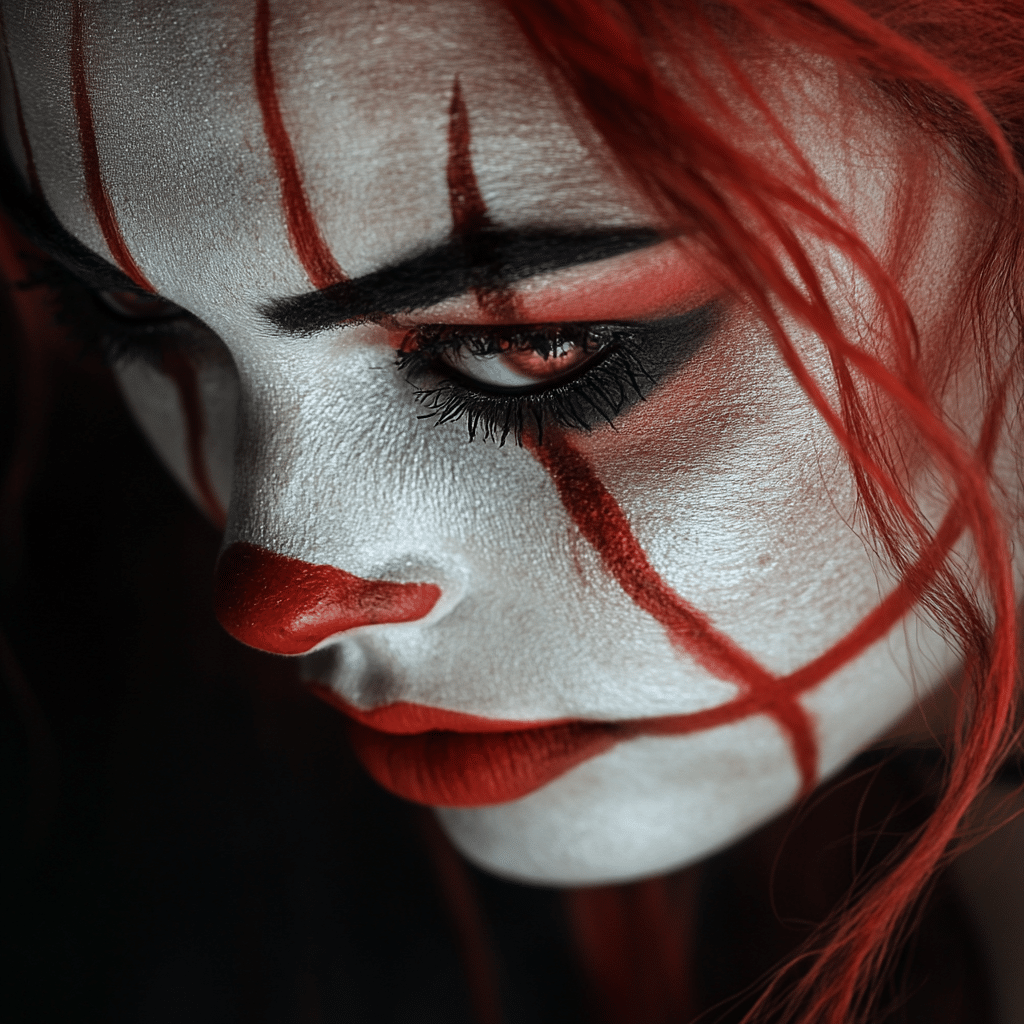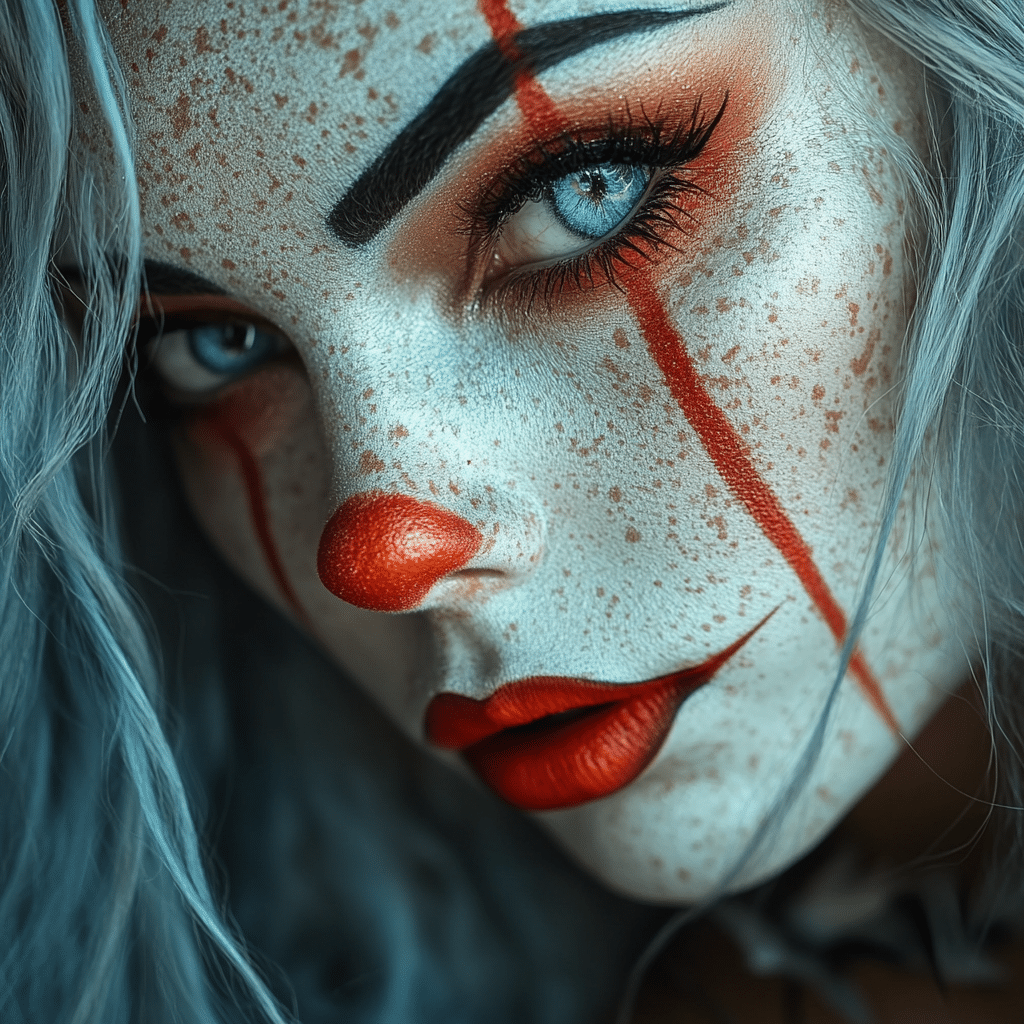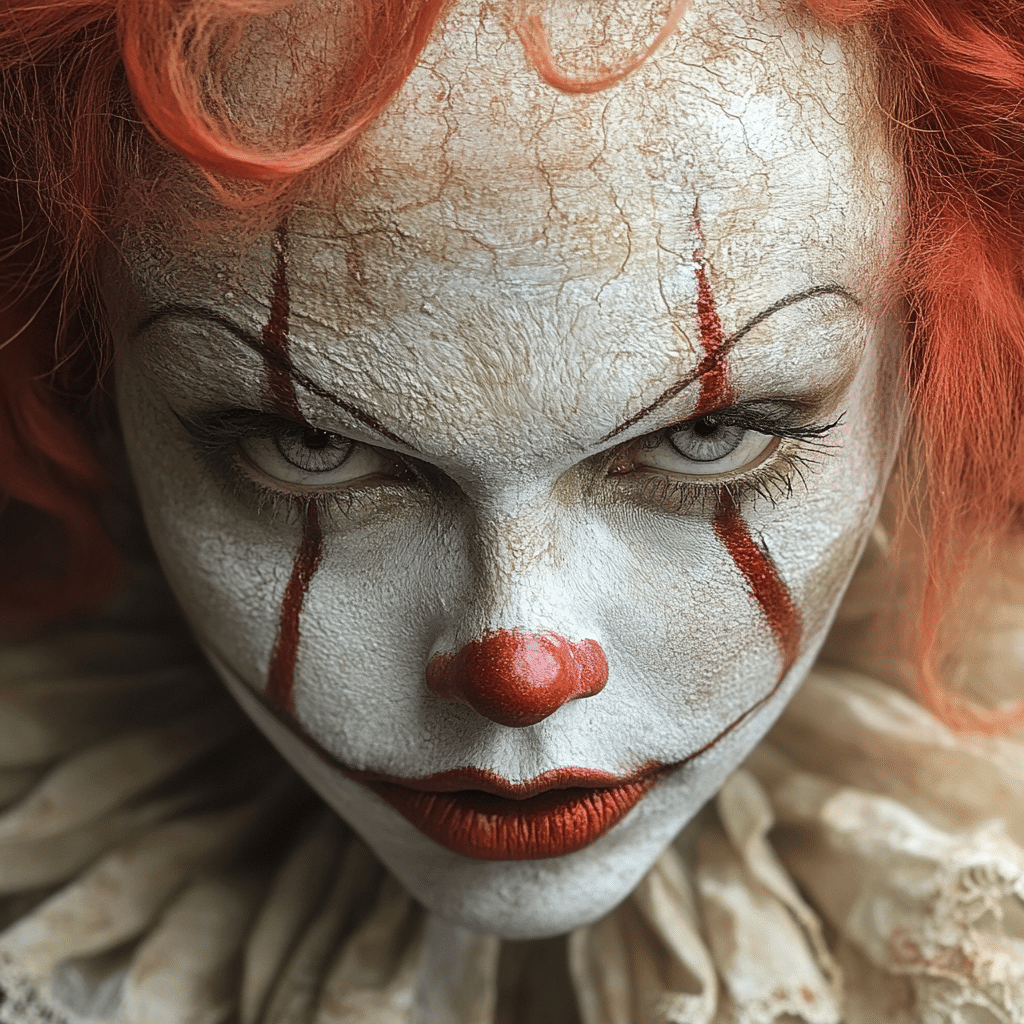The History and Evolution of Clown Face Paint
The art form of clown face paint has undergone significant transformation from its inception, now toppling over two centuries ago. At the forefront of this evolution is Joseph Grimaldi, often dubbed the father of modern clowning. Grimaldi’s influence on clown makeup has shaped performances and artistic expressions worldwide, embedding a legacy rich with history and creativity.
The Genesis of Clown Make Up: Grimaldi’s Originality
Joseph Grimaldi, born in 1778, began his journey into the art of clowning in the late 18th century. His pioneering approach to clown make up—emphasizing exaggerated facial expressions and vibrant colors—distinguished him from his predecessors. Grimaldi’s vivid white face, red cheeks, and blue eyebrows created not just a character, but a revolutionary visual language that is still recognized today. His whiteface makeup, originally designed in 1801, involved painting a white base over his face, neck, and chest, followed by the addition of red triangles on his cheeks, thick eyebrows, and large red lips set in a mischievous grin.
Techniques and Materials: Then and Now
The transition from early materials like chalk and greasepaint to today’s sophisticated cosmetic products marks a significant journey. Grimaldi’s original palette was limited, relying on natural ingredients that wouldn’t always hold up under stage lights and lengthy performances. Today, clowns benefit from an extensive range of high-quality, long-lasting make up brands like Ben Nye, Mehron, and Snazaroo. These brands offer eclectic options combining durability, safety, and vibrancy, echoing Grimaldi’s pioneering spirit but with modern enhancements.
Influential Figures in Clown Makeup History
Joseph Grimaldi: A Legacy Carved in Cosmetics
As the beacon of transformation in clown make up, Joseph Grimaldi’s impact is unparalleled. His approach laid the groundwork for a distinct category of performance art where facial expressions became amplified through make up. Grimaldi’s innovation was not merely cosmetic; it was intrinsic to the character’s narrative, acting as a medium for storytelling.
Emmett Kelly: The Tramp Clown Transformation
Another significant figure in the history of clown face paint is Emmett Kelly. Unlike Grimaldi’s bright and cheerful visage, Kelly introduced a melancholic character with “Weary Willie.” His greyscale color palette and subtle emotional cues provided a stark contrast to the traditional clown, expanding the genre’s emotional range and demonstrating the versatility of clown makeup in conveying diverse character archetypes.

| Category | Details |
|---|---|
| Origin | The original whiteface makeup was designed by Joseph Grimaldi in 1801. |
| Design Elements | – White base over face, neck, and chest – Red triangles on cheeks – Thick eyebrows – Large red lips in a mischievous grin |
| Types of Clown Makeup | White Face – Traditional clown look, extensive use of white makeup
Auguste – Reddish-brown base and exaggerated features, like large mouth and eyes, often with a prominent nose Tramp/Hobo – Darker, dirtier look, portraying a downtrodden clown Clown Light – Minimal makeup, typically focusing on specific features like eyes or mouths |
| Character Importance | Makeup must complement and clearly define the character for judges; unclear characters may lead to point loss or disqualification. |
| Application Areas | Typically applied to the face, sometimes extending to neck and upper chest. |
| Modern Usage | Many modern clowns follow Grimaldi’s design principles for the traditional White Face look. |
| Benefits | – Helps in defining and enhancing character portrayal – Adds to the theatricality and visual appeal – Maintains a historical and traditional art form |
| Price Range | Varies widely; a professional clown makeup kit can range from $20 to $150 depending on the quality and quantity of materials. |
The Science and Technique Behind Modern Clown Makeup
Understanding the Components: From Preparation to Application
Modern clown makeup artistry is as much about science as it is art. Professional clowns must understand skin types, cosmetic chemistry, and application techniques. Sticking to hypoallergenic products is critical to skin health. Brands like Kryolan offer specialized products designed to withstand intense performance conditions while protecting the skin.
Step-by-Step Guide: The Clown Make Up Process
The Cultural Impact of Clown Makeup Across the Globe
Western Clown Traditions
In the Western world, the legacy of Grimaldi is omnipresent. Clown make up is a staple in circuses, theatrical performances, and even in modern festivals such as Mardi Gras. The evolution can be traced from bright, exaggerated faces to more nuanced and character-specific make up styles.
Eastern Influence and Adaptations
Interestingly, clown makeup has also woven itself into various Eastern performance arts, such as the Kathakali dancers of India with their intricate face paintings, and the vibrant face make up of Beijing Opera performers. These cultural crossovers highlight the universal appeal and adaptability of clown make up.

Future of Clown Makeup: What Lies Ahead?
Improvements in cosmetic technology and changing cultural trends continually redefine clown make up. Innovations like LED-infused make up and 3D prosthetics are pushing the boundaries further. Additionally, the resurgence of clown therapy—using clowning as a therapeutic tool in hospitals—illustrates the evolving role of clown make up in social and humanitarian contexts.
Clown makeup remains an art form that bridges the past to the present and propels itself into the future. The whimsical yet profound legacy of Joseph Grimaldi underscores the timelessness and adaptability of this vibrant, vital facet of performance art. With each new generation, the colorful visage of the clown will continue to evolve, delight, and inspire. For those seeking a timeless art form or even looking for affordable 55 And older Apartments For rent near me, the enduring charm of clown makeup provides an ever-present source of joy and creativity.
In touching moments at places like Stourport on Severn to grand performances resonating from Rhosneigr to Thorpeness, the essence of clowning, buoyed by the distinctiveness of clown make up, remains a remarkable relic of human expression. The intricate work involved continues to captivate, much like how sports enthusiasts are drawn to updates such as Wrexham Vs Sutton united Standings. This evolving tradition stands as a testament to the influential power of creativity amid goodbye Eri or diverse local histories like The Peppermill. Even as societal trends shift, like fluctuations in Nebraska property tax, the art of clown makeup retains its profound, timeless essence.
Without a doubt, the lasting impact of clown make up, inspired by Joseph Grimaldi over two centuries ago, remains an indelible part of global cultural heritage.
Clown Make Up: The Art and Legacy of Grimaldi
Historical Tidbits
Clown make up has a deep-rooted history, tracing its origins back to the early 19th century with the iconic Joseph Grimaldi. Grimaldi’s elaborate make-up techniques, combining stark white faces with exaggerated features, became a blueprint for the classic clown look. Interestingly, Grimaldi’s vibrant face paint not only delighted audiences but also cleverly played with the emerging gaslight theatre technology, making his expressions clear from afar.
Grimaldi’s make-up was no laughing matter, as it took hours to perfect and used a combination of lead-based whiteface paint and red and black details. The commitment required artists to fully immerse themselves in the role, balancing humor with the intense effort behind the scenes. Speaking of immersive roles, many modern clowns take inspiration from Grimaldi’s dedication, often seen practicing https://www.baltimoreexaminer.com/denver-police-twitter before dawn to nail their expressions and physical comedy.
Fascinating Facts
Did you know that clowns often have their unique make-up designs registered to prevent copying among performers? This playful yet serious commitment maintains individuality in the colorful clown community. Similarly, the tradition of egg registry, where each clown’s make-up is painted on an egg, ensures they leave a lasting impression, much like Grimaldi did centuries ago.
Moreover, the distinctive white face paint has its echoes in the 20th century with the legendary Charlie Chaplin. Chaplin’s iconic character “The Tramp” borrowed heavily from clown make-up principles, merging silent film artistry with lively, expressive visuals. This cross-pollination of ideas showcases the enduring impact of Grimaldi’s pioneering work.

How to do makeup for a clown?
To do clown makeup, start by applying a white base over your face, neck, and chest. Then, add red triangles on your cheeks, thick exaggerated eyebrows, and large red lips formed into a grin. Many clowns also add their own personal touches to make their character unique.
Where did clown makeup originate?
Clown makeup originated with Joseph Grimaldi in 1801. He’s the one who first painted a white base over his face, neck, and chest and added significant details like red triangles on his cheeks, bold eyebrows, and large red lips set in a mischievous smile.
Are there rules to clown makeup?
Yes, there are specific rules to clown makeup. The makeup must complement the character being portrayed, whether it’s White Face, Auguste, Tramp/Hobo, or Clown Light. The character must be apparent to the judges; otherwise, the competitor could lose points or be disqualified.
How to paint a clown face?
To paint a clown face, you’ll need to start with a white base and then add bold features like exaggerated eyebrows, bright red lips, and cheek designs. Use a small brush for detailing and sponges for applying the base coat smoothly.
How to get smooth clown makeup?
For smooth clown makeup, make sure your face is clean and moisturized. Use a good quality clown makeup and apply it evenly with a sponge or brush. Setting powder can help to ensure a smooth finish and help your makeup stay put.
What do people use for clown makeup?
Clown makeup is typically done with greasepaint or water-based face paint. These types of makeup are designed to be bright, durable, and to provide good coverage while being easy to manipulate for detailed designs.
What are the 4 types of clowns?
The four types of clowns are White Face, Auguste, Tramp/Hobo, and Clown Light. Each type has distinctive makeup and costume that help convey their specific character and style.
Why do some girls wear clown makeup?
Some girls wear clown makeup for artistic expression or as part of a costume for events or performances. It can also be used for social media trends, or simply as a fun and unique way to play with makeup.
Why do clowns have a red nose?
Clowns often have a red nose to accentuate their facial expressions and add to their comedic appearance. It’s a classic feature that helps enhance their character’s playful or silly personality.
Is it illegal to dress up as a clown in public?
In most places, it’s not illegal to dress up as a clown in public unless it’s done with the intent to frighten or deceive people, particularly in areas where there have been issues with clown-related scares.
How do you keep clown makeup from smearing?
To prevent clown makeup from smearing, use setting powder and a makeup setting spray. Also, try to avoid touching your face throughout the day and use quality makeup that is designed to stay put.
Why do Chicanos do clown makeup?
Chicanos do clown makeup as a form of artistic expression and cultural symbolism. It often reflects themes of duality, identity, and social commentary within the Chicano community.
How to do funny clown makeup?
For funny clown makeup, exaggerate your features with brightly colored, oversized designs. Big eyes, a large red nose, and a goofy grin are common elements that can make your clown character look more humorous and entertaining.
What color are clowns lips?
Clowns typically have red lips, although some may use other bright colors depending on their specific character’s look. The lips are usually big and exaggerated to enhance facial expressions.
How to do clown lip makeup?
To do clown lip makeup, start by outlining a large, exaggerated lip shape with a red lip liner. Fill it in with a bright red lipstick or face paint, making sure the shape is symmetrical and bold.
How to turn a face into a clown?
Turning a face into a clown involves applying a white base, adding exaggerated facial features like large eyebrows, bright lips, and cheek designs. Each clown character can have unique makeup touches that make them easily identifiable.
How to cover your eyebrows for clown makeup?
To cover your eyebrows for clown makeup, use a glue stick to flatten the brows against your skin. Once dried, apply a layer of setting powder and then cover with a concealer or the white base makeup until they are fully obscured.
How to do easy Pennywise makeup?
For easy Pennywise makeup, start with a white base and add red lines running vertically from the eyes to the mouth. Darken the eyes with black or brown makeup and outline the lips with a red color that extends upward in pointed shapes.
How do clowns register their faces?
Clowns register their faces through official clown organizations by submitting a detailed photograph or a painted egg, which acts as a record of their unique makeup design. This helps protect their individual clown persona.



